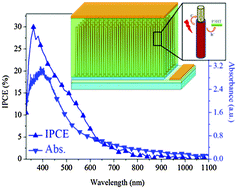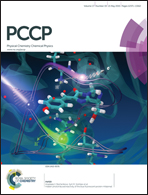ZnO@Ag2S core–shell nanowire arrays for environmentally friendly solid-state quantum dot-sensitized solar cells with panchromatic light capture and enhanced electron collection†
Abstract
A solid-state environmentally friendly Ag2S quantum dot-sensitized solar cell (QDSSC) is demonstrated. The photovoltaic device is fabricated by applying ZnO@Ag2S core–shell nanowire arrays (NWAs) as light absorbers and electron conductors, and poly-3-hexylthiophene (P3HT) as a solid-state hole conductor. Ag2S quantum dots (QDs) were directly grown on the ZnO nanowires by the successive ionic layer adsorption and reaction (SILAR) method to obtain the core–shell nanostructure. The number of SILAR cycles for QD formation and the length of the core–shell NWs significantly affect the photocurrent. The device with a core–shell NWAs photoanode shows a power conversion efficiency increase by 32% compared with the device based on a typical nanoparticle-based photoanode with Ag2S QDs. The enhanced performance is attributed to enhanced collection of the photogenerated electrons utilizing the ZnO nanowire as an efficient pathway for transporting the photogenerated electrons from the QD to the contact.


 Please wait while we load your content...
Please wait while we load your content...